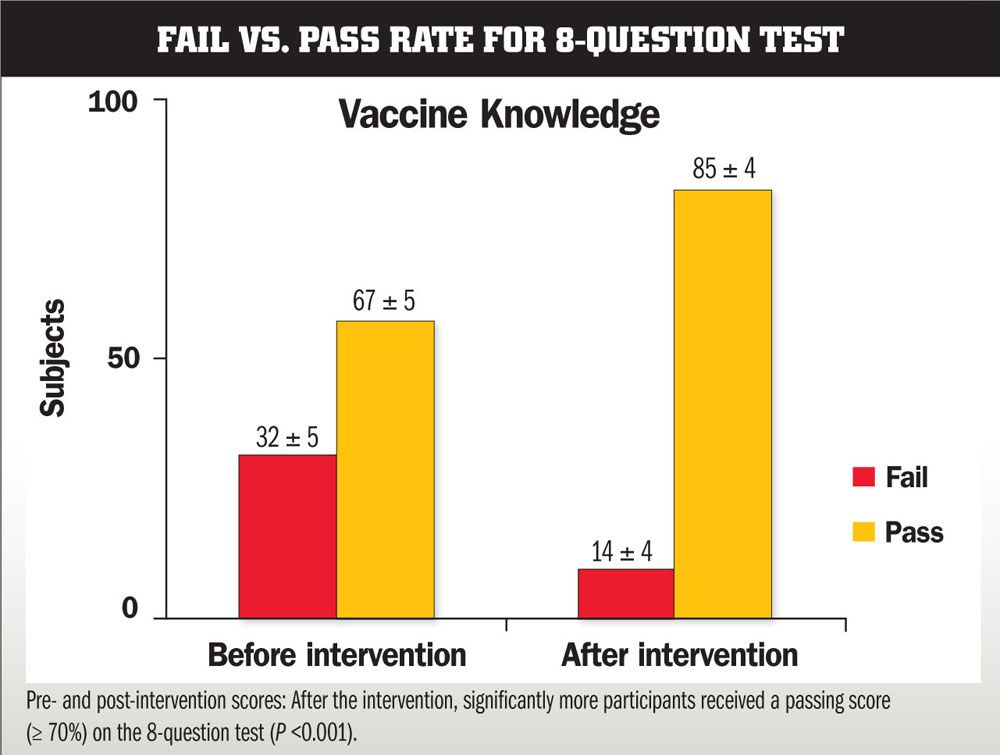Student pharmacists take immunization into the community
Advocacy and education will change attitudes

STUDENT CORNER
As immunization coordinator during my second year as a dual PharmD/MPH student, I became aware of issues that collectively lead to outbreaks of infectious diseases. Not only do parents hold misconceptions about childhood vaccinations, but there is also a lack of vaccination advocacy, and information is not readily forthcoming from healthcare providers, including pharmacists. Therefore, I took on the challenge of educating the community about vaccinations as an important means of preventive care.
With the help of our faculty advisor, my classmates and I applied for and received grants from the American Pharmacists Association (APhA) and the California Society of Health-System Pharmacists to support a study of public attitudes toward and knowledge of immunization. Under pharmacist supervision, student pharmacists provided free immunization information and vaccinations for influenza and tetanus, diphtheria, and pertussis (Tdap) to underserved communities in the East Bay area of Northern California.
Immunization issues
Influenza is the eighth leading cause of death in the United States, with 49,000 deaths occurring between 1976 and 2007.1 Over the past three years, pertussis outbreaks have resulted in 32,000 cases and 16 deaths in the nation.2
In 2010, California saw its highest pertussis outbreak in 63 years - a five-fold increase in incidence compared to the previous year’s cases. The highest rates clustered in Marin and San Luis Obispo counties, where many still believe that childhood vaccinations cause autism. Consequently, California responded to this pertussis outbreak by mandating that grades 7 through 12 receive a booster dose of Tdap.
Many studies have shown that written educational information, including pamphlets or brochures such as the Vaccine Information Statements (VIS), is not as effective as direct consultations in transmitting knowledge and influencing attitudes toward immunization.3 In addition, one-third of parents who claimed they had access to immunization information made no use of it, clinging instead to previous misconceptions.4
When parents prevent their children from being vaccinated, these children are placed at greater risk of contracting and spreading infections, and the health of the community is compromised.
The study

Our study used pharmacy students to educate the public about the benefits of vaccination. Our goal was to help change individual attitudes toward immunization by providing accurate and convincing information that would dispel the myths surrounding the issue of vaccination. We offered this service to local churches, middle schools, clinics, and homeless shelters.
Our findings demonstrated that direct education and intervention resulted in significantly improved knowledge and attitudes toward immunizations.5 The graph accompanying this article illustrates the higher rate of vaccine knowledge shown by respondents in the post-intervention survey. Most participants obtained vaccinations for protection (23.7%) and a significant 6.6% received vaccinations from us after our presentation. 5
This experience has taught me that vaccines may be available and mandates may be implemented, but if attitudes remain unchanged, many individuals will still be resistant to being vaccinated.
Outcomes
We presented the study’s preliminary results at APhA’s national American Public Health meeting in October 2012, an event attended by physicians, public health students, and pharmacy students from across the county. We were gratified to find significant interest in our project.
This initiative demonstrated that the involvement of pharmacy students successfully communicated the importance of immunization to individuals who were unaware of that importance and who were unlikely to obtain vaccination had we not intervened. It also gave us the opportunity for active service as healthcare providers.
I would like to acknowledge Dr. Aglaia Panos for her mentorship and the following team members, who made this initiative possible: Benjamin Malcolm, David Lash, Sandy Dong, Dr. Tony Chou, Dr. Layla Yousify, Dr. Keith Yoshizuka, Dr. Junhua Yu, and Dr. Bijal Shah.
References
1. Jaslow, R. Officials urge flu vaccine for unpredictable 2012-2013 season. CBS news. September 27, 2012.
2. CDC resources page. Centers for Disease Control and Prevention website. Accessed November 14, 2012.
3. Dunn, RA, Shenouda PE, Martin DR, et al. Videotape increases parent knowledge about poliovirus vaccines and choices of polio vaccination schedules. Pediatrics. 1998;102(2):e26.
4. Gust DA, Kennedy A, Shui I, Smith PJ, Nowak G, Pickering LK. Parent attitudes toward immunizations and healthcare providers: The role of information. Am J Prev Med. 2005;29(2):105–112.
5. Malcolm B, Lash D, Chou T, et al. Student pharmacist immunization education and impact on adolescent and adult immunization [poster presentation]. APHA. 2012.